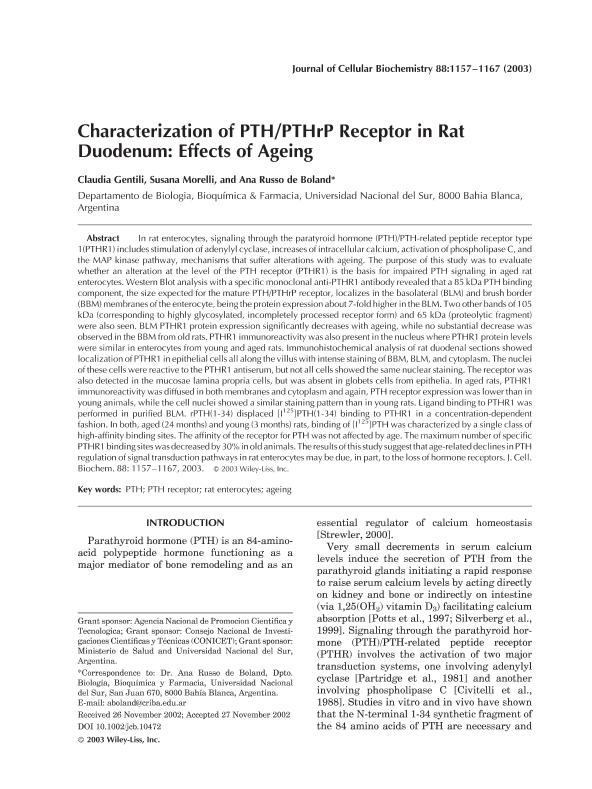Artículo
Characterization of PTH/PTHrP receptor in rat duodenum: Effects of ageing
Fecha de publicación:
04/2003
Editorial:
Wiley-liss, Div John Wiley & Sons Inc
Revista:
Journal of Cellular Biochemistry
ISSN:
0730-2312
Idioma:
Inglés
Tipo de recurso:
Artículo publicado
Clasificación temática:
Resumen
In rat enterocytes, signaling through the paratyroid hormone (PTH)/PTH-related peptide receptor type 1 (PTHR1) includes stimulation of adenylyl cyclase, increases of intracellular calcium, activation of phospholipase C, and the MAP kinase pathway, mechanisms that suffer alterations with ageing. The purpose of this study was to evaluate whether an alteration at the level of the PTH receptor (PTHR1) is the basis for impaired PTH signaling in aged rat enterocytes. Western Blot analysis with a specific monoclonal anti-PTHR1 antibody revealed that a 85 kDa PTH binding component, the size expected for the mature PTH/PTHrP receptor, localizes in the basolateral (BLM) and brush border (BBM) membranes of the enterocyte, being the protein expression about 7-fold higher in the BLM. Two other bands of 105 kDa (corresponding to highly glycosylated, incompletely processed receptor form) and 65 kDa (proteolytic fragment) were also seen. BLM PTHR1 protein expression significantly decreases with ageing, while no substantial decrease was observed in the BBM from old rats. PTHR1 immunoreactivity was also present in the nucleus where PTHR1 protein levels were similar in enterocytes from young and aged rats. Immunohistochemical analysis of rat duodenal sections showed localization of PTHR1 in epithelial cells all along the villus with intense staining of BBM, BLM, and cytoplasm. The nuclei of these cells were reactive to the PTHR1 antiserum, but not all cells showed the same nuclear staining. The receptor was also detected in the mucosae lamina propria cells, but was absent in globets cells from epithelia. In aged rats, PTHR1 immunoreactivity was diffused in both membranes and cytoplasm and again, PTH receptor expression was lower than in young animals, while the cell nuclei showed a similar staining pattern than in young rats. Ligand binding to PTHR1 was performed in purified BLM. rPTH(1-34) displaced [I125]PTH(1-34) binding to PTHR1 in a concentration -dependent fashion. In both, aged (24 months) and young (3 months) rats, binding of [I125] PTH was characterized by a single class of high-affinity binding sites. The affinity of the receptor for PTH was not affected by age. The maximum number of specific PTHR1 binding sites was decreased by 30% in old animals. The results of this study suggest that age-related declines in PTH regulation of signal transduction pathways in rat enterocytes may be due, in part, to the loss of hormone receptors. © 2003 Wiley-Liss, Inc.
Palabras clave:
Ageing
,
Pth
,
Pth Receptor
,
Rat Enterocytes
Archivos asociados
Licencia
Identificadores
Colecciones
Articulos(CCT - BAHIA BLANCA)
Articulos de CTRO.CIENTIFICO TECNOL.CONICET - BAHIA BLANCA
Articulos de CTRO.CIENTIFICO TECNOL.CONICET - BAHIA BLANCA
Citación
Gentili, Claudia Rosana; Morelli, Susana Ana; Russo de Boland, Ana; Characterization of PTH/PTHrP receptor in rat duodenum: Effects of ageing; Wiley-liss, Div John Wiley & Sons Inc; Journal of Cellular Biochemistry; 88; 6; 4-2003; 1157-1167
Compartir
Altmétricas




